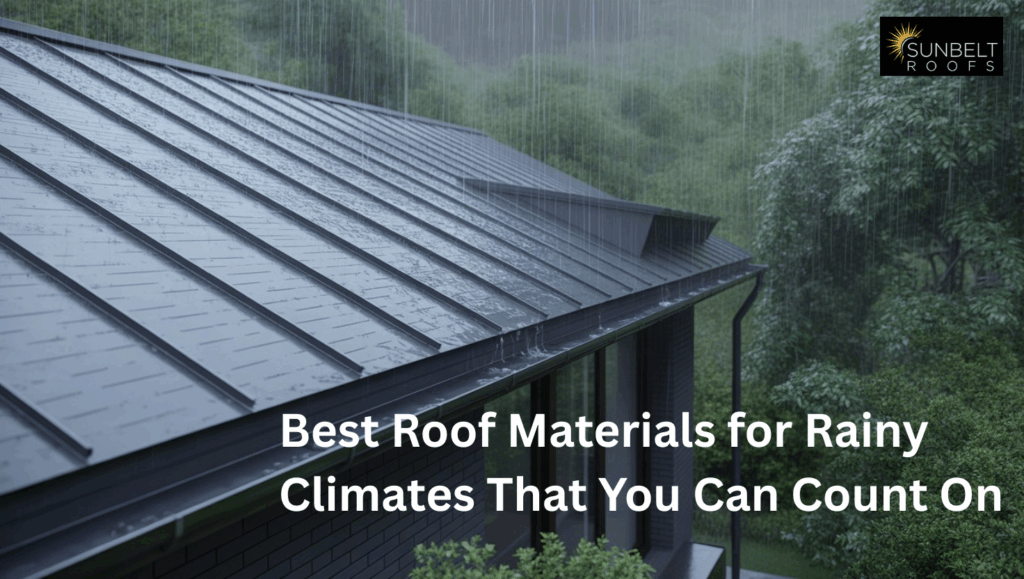
For places that have excessive rainfall, the roofing type that is adopted is something that goes beyond a construction choice; it is essential for the building’s survival. If there is a rain roof in the area, the building has a high chance of getting leaks, weakening its foundations, and causing damage to the insides of the building, too. People have started to put a focus on installing rain roofs as they provide a decent amount of stability and long-lasting performance paired with protection.
We now live in a day and age where weatherproof roofing materials and weather-resistant roofing systems are in hot demand, both in the tropics and coastal areas. What is a rain roof? We’ve put together the best materials for it to help you determine what type of roof is best for your home.
What is a Rain Roof?
Before you think of anything else, it is important to first answer, What is a rain roof? A rain roof is a roofing system that is specifically designed to protect against heavy rainfall and leaks. Unlike a conventional roof, the rain roof construction has internal features such as waterproofing, sloping drains, waterproof seal layers, and an integrated waterproofing system that prevents water from intruding into the building.
The main use of the rain roof is to protect buildings from the challenge of rain on the roof. In the case of the regions with monsoons or rains throughout the year, it acts as the first basis of protection against water. The question – what is a rain roof – is important. It helps to understand the difference between a system meant to capture precipitation from generic roofing systems.
What Type of Roof is Best for Wet Climates?
A common question from homeowners is what type of roof is best for heavy rainfall? The answer is always dependent on the slope, materials, and durability. The most preferred roof types are the sloped, as they are designed to allow water to drain. This helps deal with the issues of water pooling and leaking.
In addition to these, weather-resistant roofing systems like clay tile roofing, metal roofing sheets, or asphalt shingles roofing can all be used with effective drainage systems. Knowing what type of roof is best helps in configuring the structure to the amount of rainfall in the area. The right materials paired with a rain roof construction plan will ensure these systems last for decades, even with the constant rain on the roof. Looking for reliable Fortified Roofing Contractors Near Me? Get expert solutions designed to protect your home with strength and durability.
Weatherproof Roofing Materials for Rain Roofs
The materials used for a weatherproof roofing material ventilated rain roof construction are a crucial factor and require careful assessment to ensure moisture absorption, associated molds, and cracking do not occur.
You should consider:
- Metal roofing – Has an incredible slope and provides immediate drainage.
- Clay Tile – Ancient and remarkably fabulous, with water blocking
- Asphalt Shingles – Adequately cheap and fulfill basic requirements for slabs and slope.
Architects can utilize any of these weatherproof roofing materials to rain roof construction, ventilated. Your family will be assured of their comfort and dryness inside, as they sit cozily under a roof, while it rains on the roof.
Weather-Resistant Roofing: Key to Durability
Weather-resistant roofing is built to endure rain, but these systems are also crucial for maintaining the building’s structure and protection against wind, humidity, and excessive temperatures. Unlike standard roofing, these constructions contain weather-resistant roofing and specialized performance-boosting sealants.
These roofs adequately protect against relentless downpours, while raining on the roof, their specialized structure enhances roof longevity. If you are evaluating what type of roof is best, distribute the weight of your consideration on the weather the roof will endure instead of cost. Durable weather-resistant roofing provides for assured security of your home for the years to come. To learn more, explore Protect Your Home with Premium Weather-Resistant Roofing.
Lightweight Roofing Material For Wet Climates
The function of lightweight roofing material in wet and rainy regions is often overlooked. High roofs add unneeded strain to a building, especially when they are heavy with water. As for the lightweight roofing materials like polycarbonate sheets, fiber cement boards, or aluminum panels, they provide easy and cost-saving installation while also significantly reducing the structural load of the house.
The polycarbonate sheets, fiber cement boards, or aluminum panels also provide flexibility and resilience. They are also robust and withstand the condensation and rain on the roof. For the homeowners who are wondering, wondering what type of roof is best, lightweight, it would be all roofing materials which these days are widely being used. To explore more options, check out 10 Roof Types & How to Select the Best One.
The construction of a rain roof is all the more vital for rainy weather.
Having a rain roof construction plan is as much about what materials to use as how to use them. The engineers look at the slope design, gutters, waterproof membranes, and insulation. When it rains, all these things working together ensure your roof does not leak.
Main Features of Proper Rain Roof Construction
- Steep Slopes that allow water to drain in gutters below, puddle-sealed napkins.
- Joints, waterproof underlays,
- Tube and Threaded Rain, gutters, and downspouts.
- With these, a rain roof protects the building from structural damage while ensuring the roof does not leak, even when it rains for days.
The best roofing type on the roof type is still a matter of comparing roof materials and roof designs.
Comparing Rain Roof Options
- Clay tiles – Great for resistant roofing tiles, but quite heavy.
- Metal roofs – One of the lightweight roofing materials is very popular for roofs because of its drainage.
- Asphalt shingles – One of the cheapest roofs that is quite popular for waterproofing.
All of the above-mentioned weather-resistant roofs have advantages and disadvantages: Ultimately, the decision will be down to the environment, the money available, and the overall goal for the roof maintenance down the line. Combining the right materials and proper techniques to best construct rain roofs will give the results needed.
The designs will be discussed deeply in the text.
Rain roofs have been eco-friendlier since roofs can be constructed with materials that collect and recycle rainwater. This advantage has recently been obtained since technological sensors can be used to track and monitor the above. Metal and even solar-panel roofs are also highly resistant to extremely poor weather conditions.
All of the patents described are currently available to homeowners for purchase. Their lightweight roofs withstand dramatic weather variations and rain, combining to create a very efficient and resilient roof. Draining with the super-efficient techniques of the lightweight roofs mentioned above is a great convenience to all.
Conclusion
When it comes to wet climates, the requirements for roofing go above the standard necessities. A carefully crafted rain roof guarantees peace of mind, protection, and durability. What is a rain roof, what type of roof is best, and what are the most advanced weatherproof roofing materials are questions worth exploring if you want to make a worthwhile investment.
Choosing the right materials like clay tiles, metal sheets, or lightweight roofing, combined with quality construction rain roof, provides safety for the long term. As the industry progresses, homes will be better designed to withstand roofs raining on the roof due to advancements in weather-resistant roofing.
About Us: Our team is passionate about sharing techniques, ideas, and actionable plans to assist residential and commercial property owners in identifying roofing systems that offer enduring protection. Learn more in our About Us section.
